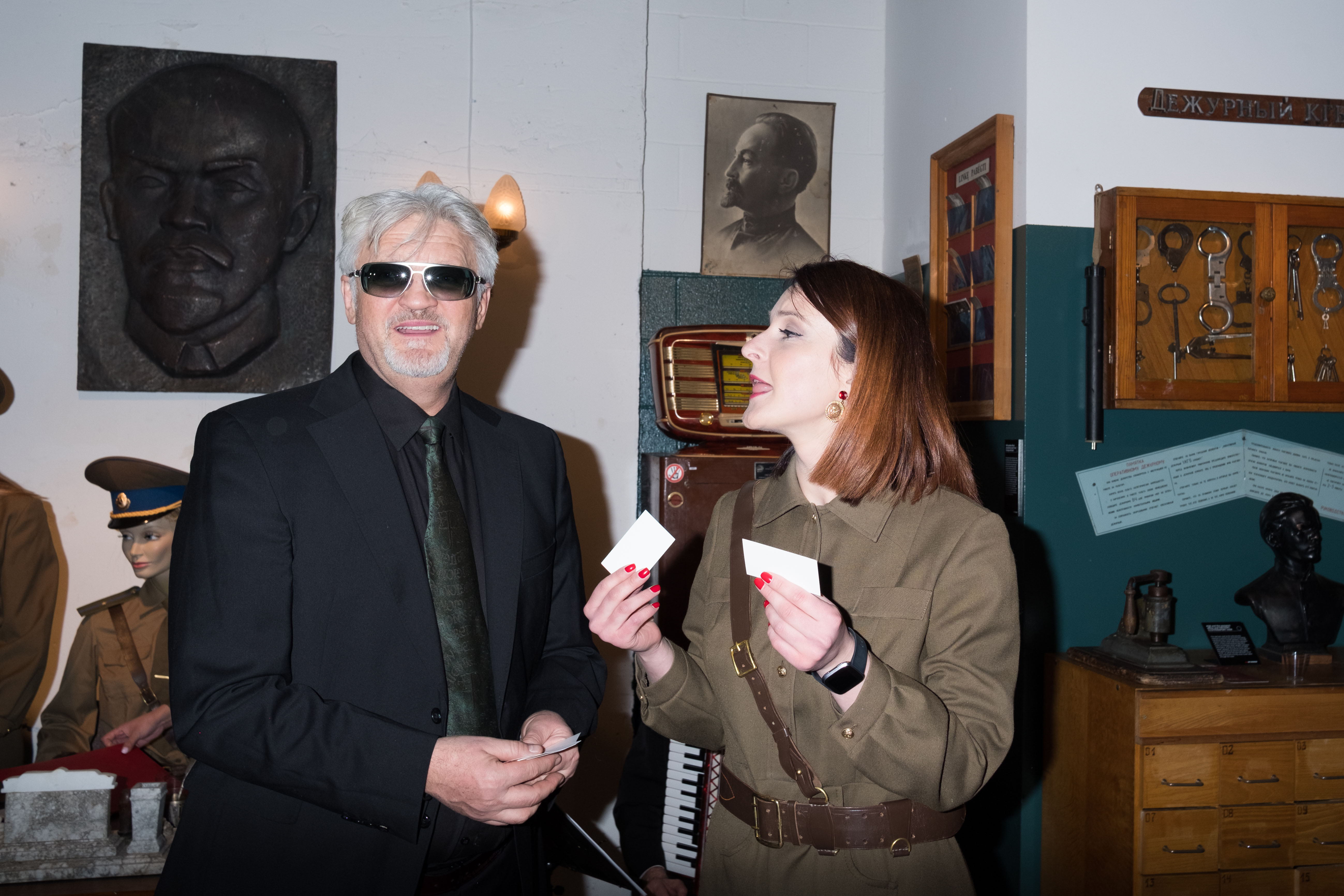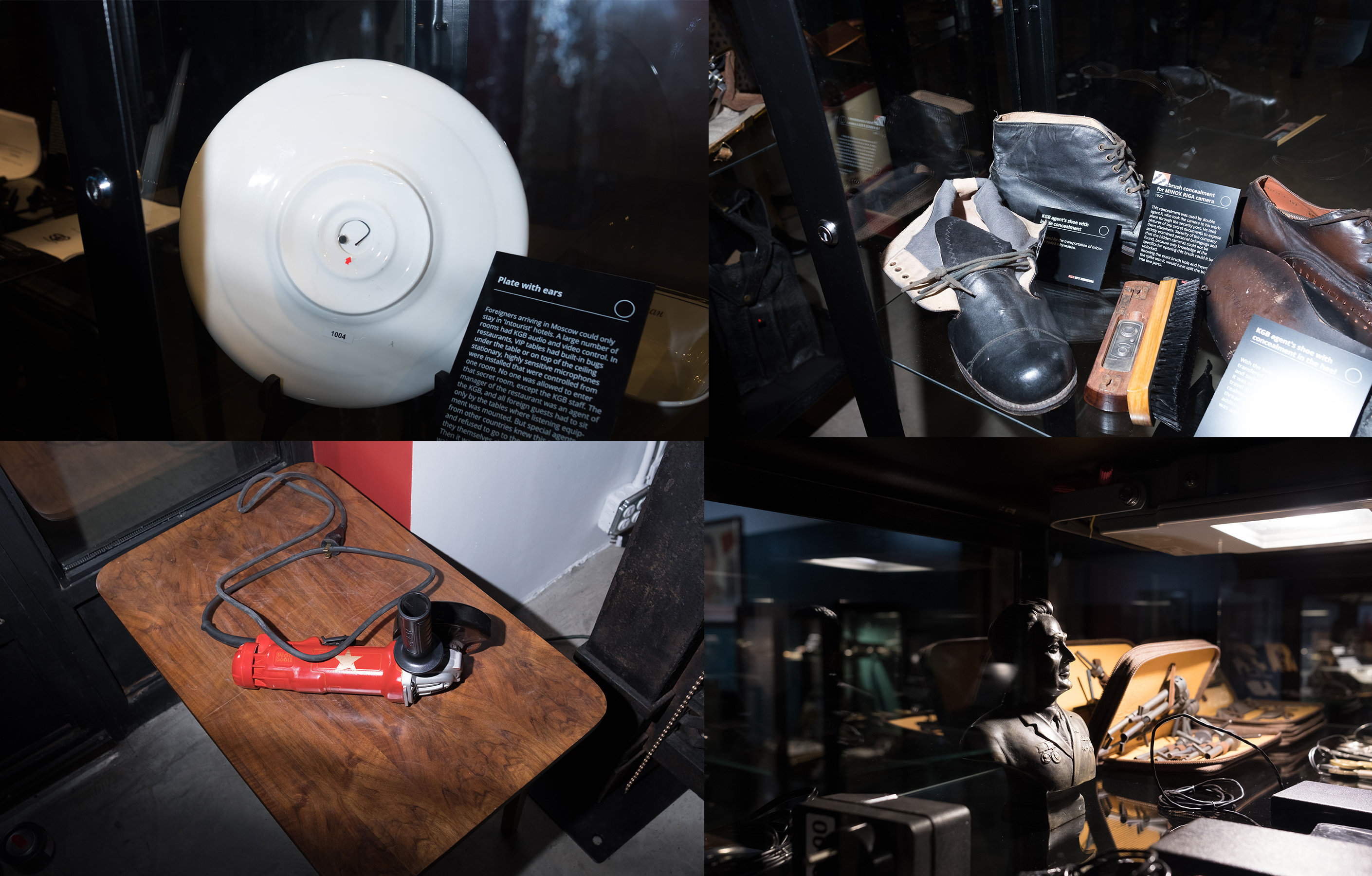At 7:15 Thursday evening, Agne Urbaityte turned on a tiny electrical saw. She was dressed in a proper Soviet officer’s uniform, and her white-haired father Julius Urbaitis—who stood silently in sunglasses, looking vaguely up to no good—watched as a piece of rope was severed and dropped to the floor for dramatic effect. It was a makeshift ribbon-cutting ceremony: Nearby, set up like a spread at a high school party from the 80s, was a table of Russian-inspired snacks (mainly puff pastries that incorporated cold eggs and smelly fish), and outside, red balloons swayed in the wind, illuminated by a string of candles placed on the sidewalk. Vladimir Lenin’s face stared out the window, sternly peering at the passers-by. Inside, a man was playing the accordion beside an assortment of multicolored vodka.
“To a brighter future,” Agne proclaimed. “Everything begins with ourselves.”
Videos by VICE

It was a cold night in Manhattan, and a crowd of journalists and other spectators who get invited to weird Communist-proximal events had gathered in Chelsea for the unveiling of what was billed as New York City’s first, and largest, KGB Spy Museum. It was equal parts kitschy and surreal, and more than once I thought about whispering a joke to a stranger about how I had stumbled into The Death of Stalin or a Coen brothers’ film. It was as if the Soviets had seized and redesigned Disney World. The extensive collection, which premiered that evening, came courtesy of the Lithuanian father-daughter duo, who operate a similar institution inside a nuclear bunker in Eastern Europe. The new spot houses, according to a press release, “3,500 rare objects, including mini cameras, spy recorders, and concealment and cipher devices.”
“My father, he just has a collector’s spirit,” Agne told me, when I asked how it all began. “Old cars. Motorcycles. And then, you know, he acquired the largest gas mask collection in Europe. It just went from there.”

She claimed their reasons for bringing the rare assortment to America, and New York in particular, were apolitical—arguing that, specifically in the city, there was a curiosity and willingness to witness a relatively lost part of history. Which is another way of saying that Americans have had a long, passionate fascination with Russia and the Soviet Union, particularly with espionage, since the Cold War—that roughly 45-year period when the world was seemingly divided in two. But it’s not often that tangible artifacts of it sit on display on this side of the erstwhile Iron Curtain.
I should pause here to admit I’m the kind of person who gets overtly enthused about this stuff. A brief, tangential example: In 2016, a copper statue of Lenin that had overlooked the Lower East Side for over two decades was removed from atop a building when the owner learned it could soon be sold to a buyer who might not have the same fondness for radical political thought. When I previously heard this might occur, a friend and I, in the sweltering New York summer heat, rode our bikes to the area and managed to gain access to the roof. Afterward, like predictable fanboys, we got a drink at KGB Bar in the East Village.

Our general bemusement notwithstanding, the larger Russia-US story is, of course, not exactly over—and the KGB, it should be said, has a long history of murder and abduction to go along with its more mildly dystopian antics. Meanwhile, after talk of a “reset” in relations during the Obama era, the two countries have been nominal foes for the better part of a decade, culminating in Russia’s interference in the 2016 election to help Donald Trump become president. And the tour itself took place mere hours before BuzzFeed News dropped an investigative story claiming Trump had urged his former attorney Michael Cohen to lie to Congress about discussions to construct a Trump Tower in Moscow. It would soon, naturally, go viral—and by the morning, members of Congress were already chattering about the president’s impeachment or resignation, Rudy Giuliani was telling reporters, “If you believe Cohen I can get you a great deal on the Brooklyn Bridge,” and liking his own texts, and Trump was tweeting about the southern border and Cohen’s father-in-law.
Meanwhile, a new display of Soviet-era spy craft, the kind employed by Putin’s old employer (the man is ex-KGB), was on offer in America’s largest city. Our long national love-hate affair was nowhere near over.

“At the moment, from the current debates about alleged White House collusion with Russia, to the success of The Americans, the KGB seems to be the subject of Americans’ combined ghoulish fascination and horror,” Mark Galeotti, an expert on Russian politics and global crime at the Institute of International Relations in Prague and VICE contributor, wrote me this week. “In some ways, it’s because of an exaggerated sense that nothing has changed—that the flag, faces, and acronyms may be different, but the covert Russian challenge is the same. But it is probably also a perverse kind of nostalgia, for a time when the ideological divides and battle lines seemed much clearer. The past always seems much more straightforward.”

But if the past is more straightforward than the present, this exhibit definitely wasn’t.
“If you do not know who he is, then we cannot begin,” our guide, Sergey Kolosov said Thursday, gesturing toward a portrait of Lenin. Sergey had the build and attitude of someone who might plant a listening device in a log near your mailbox. If only to satisfy him, everybody in the ten-person group was familiar, or at least claimed to be, with the revolutionary leader of the Bolsheviks. Really, though, Sergey could have been pointing anywhere. To his left hung Lenin’s face, printed on a tapestry. To his right, concealed behind curtains majestically blowing from the HVAC unit, sat a bust of the erstwhile leftist icon.

We proceeded, then, on what was reminiscent of a grade-school field trip—Sergey leading us throughout the open room, packed with switchboards and guns and bugging devices, offering us their histories, and, occasionally, providing his own personal anecdotes. (He shared a lengthy one that involved English lessons, a Russian restaurant, and the FBI.) More often than not, he touched an exhibition he wasn’t supposed to. As we walked, I imagined that all these artifacts could have been piled up in some middle-aged man’s basement. It’s as if they had hired Carmen Sandiego for the event planning and interior decorating. There was a recreation of a Soviet jail and, special for the night, a female prisoner in a black straitjacket, who didn’t speak. (Agne referred to her, and other silent, breathing human beings posing around the space, as “live mannequins.”) There was an archaic podium, with another live mannequin leaning against it. There were real guns from the period, which Sergey made certain to mention on multiple occasions.

But if staring at treasured memorabilia or people in straitjackets isn’t quite your thing, there were a variety of interactive portions to the establishment as well. It’s part of the sell: There was an area to snap your mugshot. Plus, have you ever wanted to try on the absurdly heavy leather overcoat and stylish cap worn by KGB agents, and then pose at a desk in front of a green screen that features—you guessed it—Lenin’s face and some Soviet flags? Or operate a camera that secretly photographs, not what’s head-on, but what’s to the right? What about getting tied to a chair? (All volunteers were, according to Sergey, “very brave.”)

But the most harped-on aspect, for sure, consisted of the ordinary objects bugged for our amusement. Those ever-perceptive plates and shelves and shoes, their ulterior use hiding somewhere inside them. Sergey suggested, proudly, that a wooden seal had recorded conversations for eight years at an American embassy—which does make you wonder, as you meander through this fantasyland, if perhaps what we’re looking for has always been there, if only we looked a little harder, if we dug a bit beneath the surface.

In time, you might conclude that most of the household items Sergey has on hand can or did double either as a camera or some sort of weapon. The question-and-answer portion of his lesson became much easier following this realization.
“You can put it on, you know, as makeup, or write some message, like, ‘I love you,” Sergey said, alluding to lipstick that could also be used as a pistol. “And then, after, you know, you can kill people with it.”
Sign up for our newsletter to get the best of VICE delivered to your inbox daily.
Follow Alex Norcia on Twitter.
Follow Jackson Krule on Instagram.




